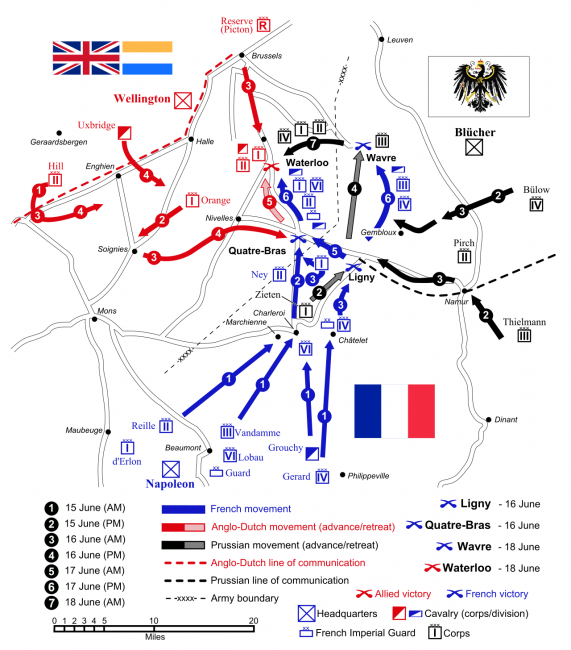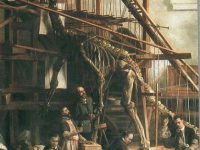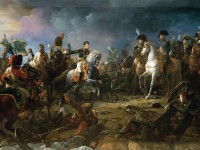
Battle of Waterloo by William Sadler
On June 18, 1815, a battle was fought near Waterloo in present-day Belgium, which should be Napoleon’s last. An Imperial French army under the command of Emperor Napoleon was defeated by the armies of the Seventh Coalition, comprising an Anglo-Allied army under the command of the Duke of Wellington combined with a Prussian army under the command of Gebhard von Blücher. The defeat at Waterloo ended Napoleon’s rule as Emperor of the French, and made way for a shift in the European balance of power.
The Most Prominent Location in Belgium
Maybe Waterloo is the most prominent location in Belgium, at least for non-Europeans. Nowadays, of course every European knows Brussel as the capital of Belgium, because it is also the seat of the EU parliament. But, back in the 19th century, an insignificant spot on the landscape thirteen kilometres south of Brussels called Waterloo should become known to almost everybody, because one of the most important battles ever fought in Europe took place. The strategic location of Waterloo on a paved road towards Brussels explains why the battle took place just south of Waterloo. It was important for the allies to stop Napoleon from reaching Brussels, and Waterloo was the last settlement to cross before negotiating the forest and getting to Brussels.
The Congress of Vienna and Napoleon’s Escape from Exile
But, lets get back a little bit further to understand the Prelude that lead to this most significant battle. The European powers were meeting in Vienna to re-establish the territorial balance in Europe when news came of Napoleon’s escape from his exile in Elba on 1st March 1815 and his re-entry into Paris on 20th March. The powers immediately renewed their declaration of war on Napoleon and the 7th Coalition between Britain, Austria, Prussia and Russia was formed on 25th March and they began assembling their troops in readiness for war. Their intention was to attack along the French borders and march on Paris from different directions with enough strength to crush Napoleon and the French.
Wellington and Blücher
But, only the armies of the Duke of Wellington and the Prussians under Marshal Blucher were in place in Belgium, while the others arrived only after Napoleon had been defeated. 23,000 British troops together with 44,000 allied troops and 160 guns stood against 74,000 French troops and 250 guns. Seizing the moment, Napoleon led his troops north with the aim of defeating his enemies individually before they had the chance to unite. Together they would be too much for his forces. While his efforts were initially successful, in a clash at Ligny on June 16, Napoleon routed the Prussians at a high cost. The Prussian centre was destroyed and Blucher almost killed, they were forced to withdraw to Wavre. The Prussians had lost about 16,000, and another 8,000 deserted during the night. Napoleon then turned his attention to the British who made a stand at the small town of Waterloo.
At the Small Town of Waterloo
On the morning of June 18, the two armies faced off against each other. However the incessant rains of the previous days had soaked the ground to a muddy morass hampering all movements of men, horses and artillery. This postponed the battle until midday when Napoleon opened up with an artillery barrage. The fighting seesawed back and forth throughout the day with high casualties on both sides. Towards evening Wellington’s exhausted troops seemed on the verge of breaking, but the timely arrival of the Prussians reinvigorated their efforts and doomed Napoleon. According to Wellington, the battle was “the nearest-run thing you ever saw in your life.”

Map of the Waterloo campaign
Why Napoleon Lost
Napoleon himself had lost his accustomed firm and cold-blooded attitude on this day and by the last desperate attack had to take military responsibility for the destruction of his army and thus the loss of his hundred day rule. From a historical point of view, three mistakes made by Napoleon before the battle are usually mentioned:
- On the morning of 17 June Napoleon could have crushed Wellington with his superiority in infantry and above all artillery, while the Prussians were still retreating to Ligny. Instead, he visited the wounded that morning. He also failed to give Ney the immediate order to attack.
- His second mistake was to underestimate Wellington’s tactical skill and British cold-bloodedness.
- The third mistake was his overconfidence. According to information from his brother Jérôme, who had learned of the Prussian plans from a waiter at the Roi d’Espagne inn, he should have ordered Grouchy to Wavre immediately. In this case, only Corps v. Bülow would have succeeded in appearing on the battlefield. Napoleon was of the opinion that after the Battle of Ligny the Prussians would not succeed in quickly recovering from the battle and attacking again.
Aftermath
Napoleon abdicated, surrendering to the British, and was exiled to Saint Helena, where he died in 1821. The battlefield is in present-day Belgium, about 12 km south of Brussels, and about 2 km from the town of Waterloo. The site of the battlefield is today dominated by a large mound of earth, the Lion’s Hillock. As this mound used earth from the battlefield itself, the original topography has not been preserved.
Waterloo: Causes, Courses and Consequences – Professor Sir Richard Evans FBA, [7]
References and Further Reading:
- [1] The Battle of Waterloo at BBC
- [2] Waterloo at British Battles
- [3] Waterloo 200 – 1815-2015
- [4] The Battle of Waterloo at Google Maps
- [5] The Battle of Waterloo at EyewhitnessHistory
- [6] Works and documents about the Waterloo Campaign at Wikisource
- [7] Waterloo: Causes, Courses and Consequences – Professor Sir Richard Evans FBA, Gresham College @ youtube
- [8] Chesney, Charles C. (1874), Waterloo Lectures: A Study Of The Campaign Of 1815 (3rd ed.), Longmans, Green, and Co
- [9] Clausewitz, Carl von; Wellington, Arthur Wellesley, 1st Duke of (2010), Bassford, Christopher; Moran, Daniel; Pedlow, Gregory W. (eds.), On Waterloo: Clausewitz, Wellington, and the Campaign of 1815., Clausewitz.com
- [10] Comte d’Erlon, Jean-Baptiste Drouet (1815), Drouet’s account of Waterloo to the French Parliament, Napoleon Bonaparte Internet Guide
- [11] Maps with Battles of the Napoleonic Wars, via DBpedia and Wikidata





